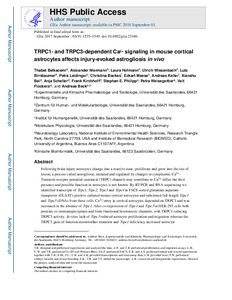Please use this identifier to cite or link to this item:
https://repositorio.uca.edu.ar/handle/123456789/8724| Título: | TRPC1- and TRPC3-dependent Ca2+ signaling in mouse cortical astrocytes affects injury-evoked astrogliosis in vivo | Autor: | Belkacemi, Thabet Niermann, Alexander Hofmann, Laura Wissenbach, Ulrich Birnbaumer, Lutz Leidinger, Petra Backes, Christina Meese, Eckart Keller, Andreas Bai, Xianshu Scheller, Anja Kirchhoff, Frank Philipp, Stephan E. Weissgerber, Petra Flockerzi, Veit Beck, Andreas |
Palabras clave: | TEJIDO NERVIOSO; CELULAS; CEREBRO; CORTEZA CEREBRAL; HERIDAS | Fecha de publicación: | 2017 | Editorial: | Wiley | Cita: | Belkacemi T, Niermann A, Hofmann L, et al. TRPC1‐ and TRPC3‐dependent Ca2+ signaling in mouse cortical astrocytes affects injury‐evoked astrogliosis in vivo [en línea]. Glia. 2017;65(9):1535-1549. doi:10.1002/glia.23180 Disponible en: https://repositorio.uca.edu.ar/handle/123456789/8724 | Resumen: | Abstract: Following brain injury astrocytes change into a reactive state, proliferate and grow into the site of lesion, a process called astrogliosis, initiated and regulated by changes in cytoplasmic Ca2+ . Transient receptor potential canonical (TRPC) channels may contribute to Ca2+ influx but their presence and possible function in astrocytes is not known. By RT-PCR and RNA sequencing we identified transcripts of Trpc1, Trpc2, Trpc3, and Trpc4 in FACS-sorted glutamate aspartate transporter (GLAST)-positive cultured mouse cortical astrocytes and subcloned full-length Trpc1 and Trpc3 cDNAs from these cells. Ca2+ entry in cortical astrocytes depended on TRPC3 and was increased in the absence of Trpc1. After co-expression of Trpc1 and Trpc3 in HEK-293 cells both proteins co-immunoprecipitate and form functional heteromeric channels, with TRPC1 reducing TRPC3 activity. In vitro, lack of Trpc3 reduced astrocyte proliferation and migration whereas the TRPC3 gain-of-function moonwalker mutation and Trpc1 deficiency increased astrocyte migration. In vivo, astrogliosis and cortex edema following stab wound injury were reduced in Trpc3-/- but increased in Trpc1-/- mice. In summary, our results show a decisive contribution of TRPC3 to astrocyte Ca2+ signaling, which is even augmented in the absence of Trpc1, in particular following brain injury. Targeted therapies to reduce TRPC3 channel activity in astrocytes might therefore be beneficial in traumatic brain injury. | URI: | https://repositorio.uca.edu.ar/handle/123456789/8724 | ISSN: | 1098-1136 | Disciplina: | MEDICINA | DOI: | 10.1002/glia.23180 | Derechos: | Acceso Abierto | Fuente: | Glia. 2017;65(9):1535-1549 |
| Appears in Collections: | Artículos |
Files in This Item:
| File | Description | Size | Format | |
|---|---|---|---|---|
| trpc1-and-tprc3-dependent.pdf | 1,2 MB | Adobe PDF |  View/Open |
Page view(s)
235
checked on Dec 24, 2025
Download(s)
276
checked on Dec 24, 2025
Google ScholarTM
Check
Altmetric
Altmetric
This item is licensed under a Creative Commons License

